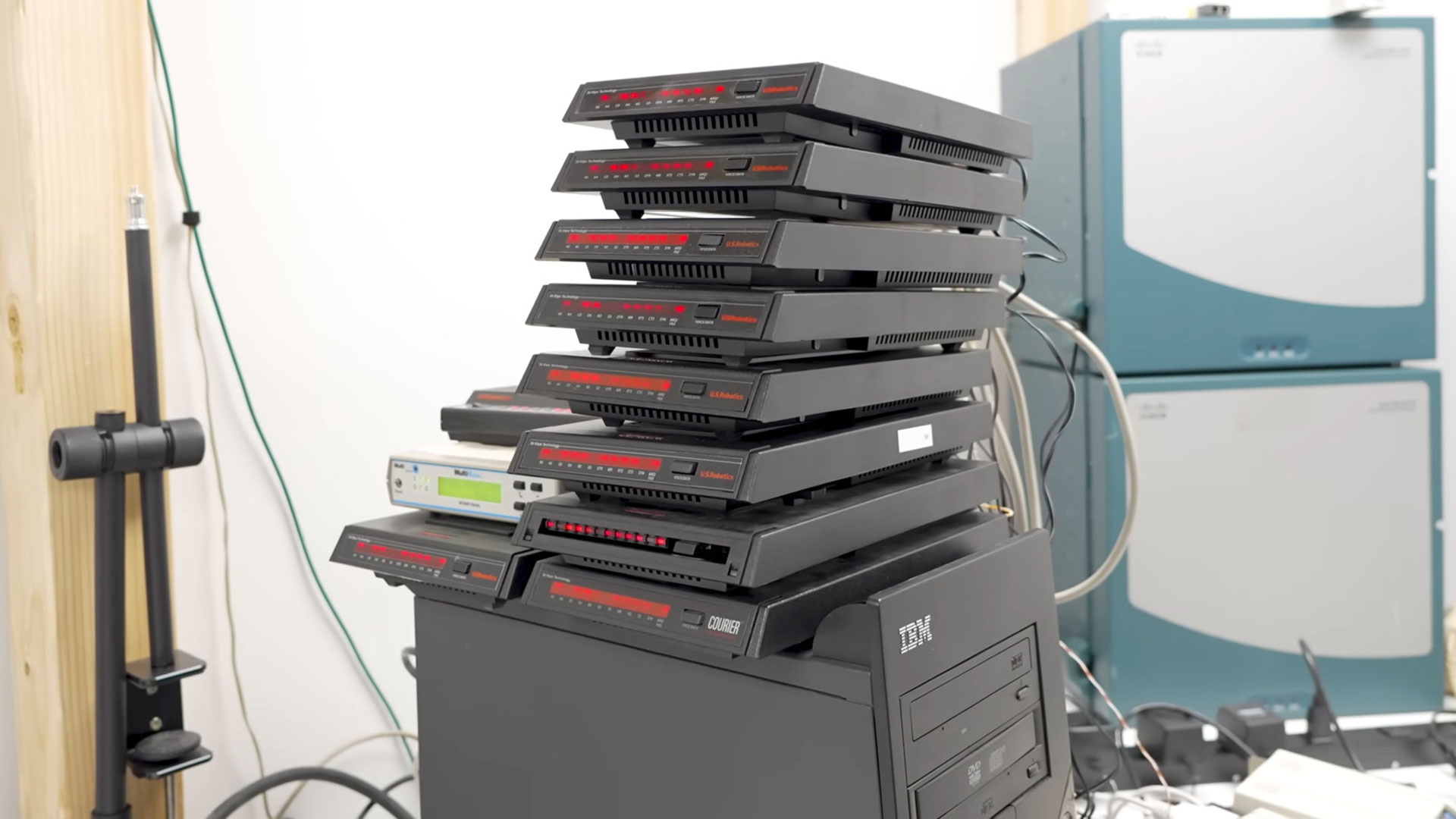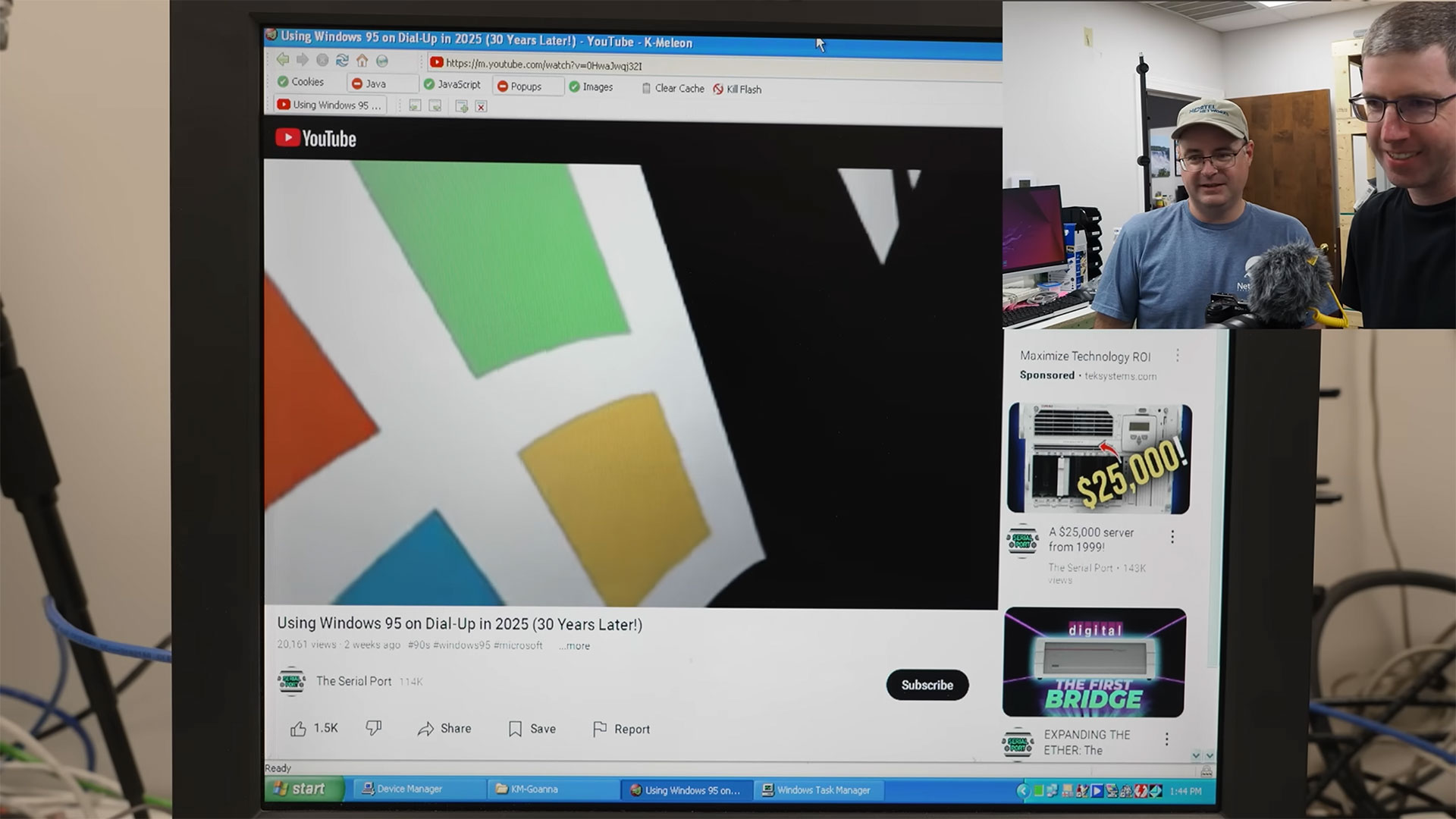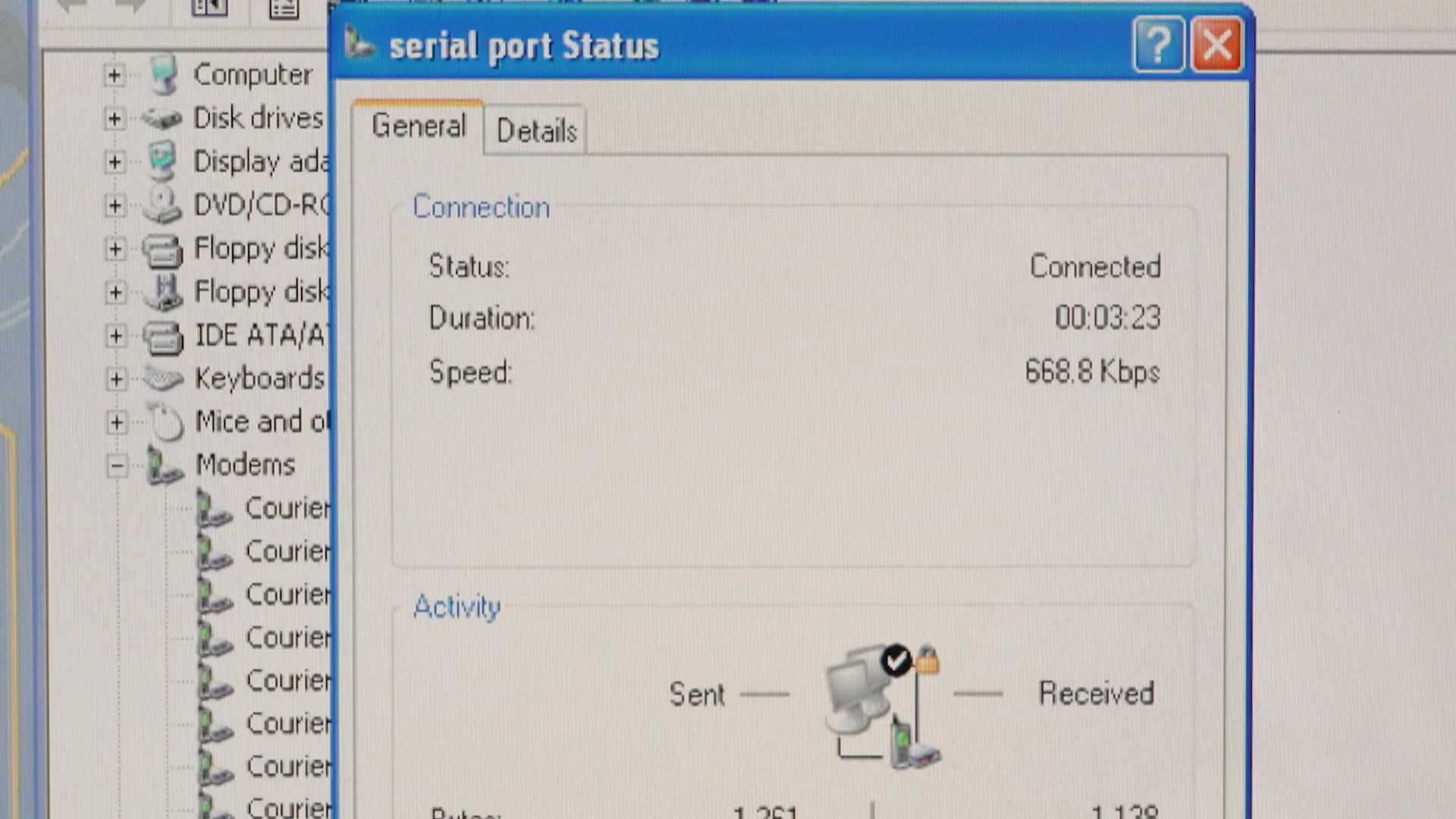Enthusiasts bond twelve 56K modems together to set dial-up broadband records — a dozen screeching boxes achieve record 668 kbps download speeds
Multilink PPP worked well on an era-appropriate Windows XP PC, after progress using an earlier Windows ME box stalled.

The latest episode published by tech channel The Serial Port began with an interesting question: Is it possible to stream YouTube via dial-up internet? As the headline suggests, the answer is a resounding yes, with our intrepid heroes managing to establish a connection offering download speeds of 668.8 kbps. The feat was eventually achieved using an era-appropriate Windows XP PC, a Cisco VoIP unit, a couple of serial port packing PCI cards, and a dozen 56K modems bonded using Multilink PPP (MPPP) technology. This is probably a world record.

When broadband wasn’t so broad
The latest regulations from the FCC define broadband as 100 Mbps or higher, but in 2000, a far slower connection of 200 Kbps or higher was considered adequate to earn the designation. Back then, connectivity was slow, but by the turn of the millennium, websites and communications were simpler and had lower bandwidth. For example, downloading multimedia files like MP3s back then could tie up your phone line for 10 to 20 minutes. Thus, applications like the infamous Napster and emerging streaming video and online multimedia experiences begged for broadband.
Multilink PPP technology was one possible solution to faster internet connectivity before ISDN and ADSL connectivity became widespread. As the name suggests, MPPP tech combines the bandwidth of multiple modems to create a single logical data pipe.
Commercial solutions like “the Diamond Multimedia Shotgun, a PCI card with two onboard modems that could be bonded together using multilink PPP,” leveraged this tech, point out the YouTubers. However, it didn’t gain traction due to the multiple lines and ISP shenanigans required.
Now, with an ISP that supports digital modems and the equipment (including a Cisco VoIP gateway) to make it happen, The Serial Port had an opportunity to see how far Multilink PPP can go. Encouragingly, the official MPPP standard doesn’t highlight any practical limits…
Cover your ears - Preparing for screeching modem broadband
Refocusing on the overarching YouTube streaming goal, our intrepid TechTubers calculated how much bandwidth would need to be squeezed out of their bonded modem array to make streaming tolerable. In brief, ~four 56K modems should be sufficient for minimum-quality desktop streaming (240p, ~200 kbps) in 2025.
The first client PC chosen was a 2001-vintage IBM desktop with Windows ME, released just ahead of the widespread availability of broadband. This setup worked with two 56K modems bonded together—a promising start.
Get Tom's Hardware's best news and in-depth reviews, straight to your inbox.
With the proof that MPPP worked on this contemporaneous PC system, the TechTubers sought to pack more serial ports into the IBM. A card featuring an extra eight serial ports was found. However, driver clashes prevented further scaling…
Still optimistic about their project, the team moved up to “slightly newer hardware.” Specifically, an IBM Think Center from 2004 was chosen as a compromise, as we did not want to go too modern. Windows XP was pre-installed on this system, and it was hoped that it could do better with MPPP.
Using the newer XP PC, two identical serial expansion cards were installed. However, they didn’t work together, as they overlapped COM port addresses in the Device Manager. So the TechTubers switched to a different brand of serial expansion card for the second card. They ended up with 13 ports in total (including the one on the motherboard).
The dusty dozen
Unlike with Windows ME, where each modem was dialed in turn, it was observed that XP dialed them all simultaneously! Moreover, the team successfully scaled up from two modems to 12 after several rounds of fiddling with modem DIP switches, phone line connectors, and XP’s serial port controls. As more modems were added to the system, the TechTubers laughed joyously at the sound of multiple modems dialing and negotiating.
The dozen modems connected to the Windows XP machine achieved a combined connection speed of 668.8 kbps, offering blistering download speeds. Testing confirmed that this system was able to load and stream YouTube videos, and no buffering was observed after a slight delay (likely due to the old PC's processing power).
Did The Serial Port achieve a world record? The TechTubers couldn’t find any accounts of people using more than four modems in MPPP at the same time. The video ends with a tease that they haven’t yet found a limit to MPPP…
Follow Tom's Hardware on Google News, or add us as a preferred source, to get our up-to-date news, analysis, and reviews in your feeds. Make sure to click the Follow button!

Mark Tyson is a news editor at Tom's Hardware. He enjoys covering the full breadth of PC tech; from business and semiconductor design to products approaching the edge of reason.
-
ggeeoorrggee ReplyThe latest regulations from the FCC define broadband as 100 Mbps or higher, but in 2000, a far slower connection of 200 Mbps or higher was considered adequate to earn the designation.
Pretty sure you mean 200 Kbps there.
I love this idle use of old modems. Best I ever did was dual modems — thankfully replaced by AT&T cable modem 10 months later. -
atomicWAR Reply
Those were the days. My first broadband connection was a cable modem. I had 768Kbps and it screamed.ggeeoorrggee said:Pretty sure you mean 200 Kbps there.
56k was what my first adult owned computer had. But I remember hacking my mom's work innocently in 3rd grade to watch her companies main frame crash during a lightning storm as I was told it would (was a company joke and fact). Her coworker may have egged me on to try it... And that was on the old acoustic coupler's that had 300 bits per second. Good times. -
Zaranthos The per line cost plus taxes probably far exceed the cost of most broadband options. But if latency matters it would probably be faster than satellite internet, but most likely less bandwidth. Land based broadband still doesn't exist everywhere phone lines are installed. In the USA all the promises of "rural broadband" usually result in millions to billions of dollars of wasted money with little actual increased coverage.Reply -
davidjao Reply
Most other satellite providers have worse latency than dialup, but Starlink is the exception. Starlink has very low latency.Zaranthos said:The per line cost plus taxes probably far exceed the cost of most broadband options. But if latency matters it would probably be faster than satellite internet, but most likely less bandwidth. Land based broadband still doesn't exist everywhere phone lines are installed. In the USA all the promises of "rural broadband" usually result in millions to billions of dollars of wasted money with little actual increased coverage. -
orbatos Reply
Latency on dial-up was heavily dependant on physical line quality, but could be quite good, especially once digital infrastructure started to catch up and lines were switched closer to origin. In fact, dual line connections for business configured configured for line based duplex allowed for locally hosted services like email alongside normal operations and multiplayer online gaming in the evenings.Zaranthos said:The per line cost plus taxes probably far exceed the cost of most broadband options. But if latency matters it would probably be faster than satellite internet, but most likely less bandwidth. Land based broadband still doesn't exist everywhere phone lines are installed. In the USA all the promises of "rural broadband" usually result in millions to billions of dollars of wasted money with little actual increased coverage.
As for rural broadband investment, two things.
Firstly, it did dramatically increase availability of internet access and schooling across the US. It couldn't fix everything without continued efforts as some infrastructure didn't exist at all, fragile grant based funding wasn't going to cut it. Then there was the resistance from telcos who didn't want to build where there were less customers and more expensive maintenance.
Secondly, who wasted money? It was broadband monopolies. In several cases this was outright fraud, signing off on a multi-billion contract and doing literally no infrastructure work for years before asking for more money (Comcast). Mature no mistake, the telcos saw this as free money, not something they were interested in. Federal and state oversight were also very lax in these cases, signalling that even many senators just saw it as a kickback rather than something important. -
Sluggotg Modems were cool back in the day. Late one night I get all these calls from some Drunken dirt bag. He keeps yelling at me claiming, "I know Suzy is with you" Blah, Blah, Blah. I keep warning him to stop calling me. I finally have enough, (it is around 2 AM). So I fire up my modem to call him and keep calling until it gets a handshake signal. I had it call him till the next evening. He never called back and no I don't know who he was or who Suzy was.Reply -
trainwrek This is legit. I used to bond multiple t1 and ISDN lines off cisco routers with MPPP. Fastest and most expansive I did was 4 T1s for ~6mbps for an office of about 250 people. The internet was so different back then though. That was crazy fast and cost almost 4k a month.Reply
Only ever did 2 of those roberts modems off a cisco for a branch office. Each modem would never connect faster than 48kbps so less than 100kbps when bonded. -
Vanderlindemedia I seriously enjoyed a project like this. The simultaneously sound going on when trying to connect all 12 modems lol. The speed is actually well above 600kbps. The latency however must be insane.Reply -
hookenz Quite sure those are US Robotics modems, not Cisco. They were the best of the best. Rock solid connection reliability but cost an arm and a leg back in the day. Seeing this brought back some memories. Great post.Reply -
hookenz Reply
Yeah 200MBits in the year 2000 was rare. 2MBit/s was enough. Most people had ADSL or cable modem back then. Up to 2-10mbit/s was common.ggeeoorrggee said:Pretty sure you mean 200 Kbps there.
I love this idle use of old modems. Best I ever did was dual modems — thankfully replaced by AT&T cable modem 10 months later.
